The Role of the Queen and the Dauphin
Equally concerned with contemporary problems, other manuscripts of the chronicle painted by the Master of the Cité des Dames focus on the queen and the dauphin rather than the dukes. The pictures in a Grandes Chroniques now in Paris (Mazarine 2028), which predates the assassination of Louis of Orléans in 1407, provide nonpartisan commentary on the conflict between Louis of Orléans and John the Fearless and the importance of Queen Isabeau of Bavaria's role in politics. A second chronicle, in Brussels (B.R. Ms. 3), dates from the second decade of the fifteenth century when the dauphin, Louis of Guyenne, approached his maturity; some of its images refer to the importance of his education. Together these books address additional issues of concern to the court and to Parisian intellectual circles in the first part of the fifteenth century. Like the chronicles in Berlin and New York, they could be termed royalist books. They support those who sought to preserve the French monarchy but concentrate on different agents of preservation.
An imposing frontispiece and three rare subjects gloss French history with contemporary commentary in the Grandes Chroniques from the Bibliothèque Mazarine. As in Phillipps 1917, pictures in this chronicle include arms and devices that identify figures from French history with contemporary personages. They celebrate the French dynasty and comment on the civil war in France.
The Trojan frontispiece (Fig. 100) embodies a dynastic theme. Within this miniature, two boats fleeing the burning city of Troy display the arms of France and Brittany. This juxtaposition is perplexing at first, because the text of the chapter describes the refugees from Troy but does not mention the Bretons. Instead, the chronicle notes three major countries founded by Trojan refugees: Italy, founded by Aeneas; Britain, by Brut; and France, by Francion.
This use of Breton arms becomes clear when we consider the source for the description of Brut's life in the Grandes Chroniques , Geoffrey of Monmouth's History of the Kings of Britain .[21] Geoffrey's text stresses the interrelated histories of Britain and Brittany, which was colonized by the descendants of Brut. When Britain was in difficulty, the Bretons sent armies to aid their island relatives. War, pestilence, and famine, however, eventually defeated the Britons, who emigrated as a nation to Brittany. Thus, as Geoffrey of Monmouth describes it, "From that time, the power of the Britons ceased in the island, and the Angles began their reign."[22] Although the Grandes Chroniques never refers explicitly to the history of Brittany, it does echo Geoffrey: "From this Brut descended all the kings who were in the land [Britain] up until the time when the English, who came from one of
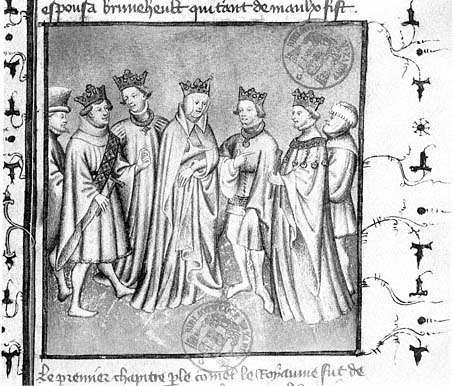
Figure 117
Queen Clotilda divides the realm among her sons. Grandes Chroniques de France .
Bibliothèque Mazarine, Ms. 2028, fol. 14. Photograph by the author.
the countries of Saxony called Angle, took the land for which [reason] it is called England."[23] We could say, then, that the Trojan refugees in this miniature bear Breton arms because the Bretons, rather than their English supplanters, were of Trojan descent.
Contemporary history provides another motive for the use of Breton arms. In 1396, Jeanne of France, third daughter of Charles VI and Isabeau of Bavaria, married John of Montfort, heir to the duchy of Brittany.[24] The alliance of these two houses was politically motivated. Notoriously independent, Breton dukes placed the security of their duchy before their duties as vassals of the French king. By securing a marriage tie with the Breton house, the French sought to strengthen relations between the Bretons and the French. The heraldic display in the frontispiece thus implies that the recent connection of the two houses has its roots in their shared Trojan ancestry.
Other pictures in the chronicle refer to internal French politics. For example, the illustration to the second book (Fig. 117) shows Queen Clotilda dividing the realm among her four sons, pictured as kings. Two of these kings have special attributes: the king at the far right clasps a stick, and the king at the far left holds a schematized hammer. These are generalized references to the political emblems of Charles VI's brother and cousin—the bâton noueux or knotty stick of Louis,
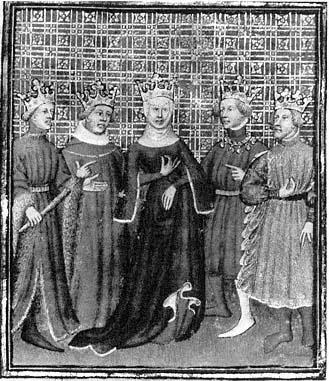
Figure 118
Queen Clotilda divides the realm among her sons. Grandes
Chroniques de France . Berlin, Deutsche Staatsbibliothek,
Phill. 1917, fol. 14. Photograph: Deutsche Staatsbibliothek Berlin.
duke of Orléans, and the hammer of John the Fearless, duke of Burgundy.[25] The history of Queen Clotilda's sons clarifies the references to these noble cousins.[26] After Clotilda partitioned the realm, two of her sons formed a greedy alliance to battle one of their brothers. Only Queen Clotilda's active intervention prevented fratricide. The use of Burgundian and Orléanist emblems in a scene of Clotilda and her sons may therefore comment on the deadly rivalry between these blood relations of Charles VI.
The timeliness of this image is confirmed by representations in the two later manuscripts of the Master of the Cité des Dames , neither of which includes the simplified hammer. In the pro-Burgundian manuscript, Phillipps 1917, for example (Fig. 118), Clotilda's son at the far left is the only one to retain his emblem. Without the opposing hammer, the baton loses its overlay of political meaning and serves as a neutral sign of office.[27]
The inclusion of Clotilda with her sons may also address a second theme that permeated royalist, as opposed to Burgundian or Orléanist, political writings of the early fifteenth century—the importance of the queen in governing the realm. Certainly the theme of queenly power is expressed in two other pictures from the Paris manuscript: the coronation of Charlemagne's son, Louis the Pious, as King of Aquitaine (Fig. 119) and the discussion of the royal succession after the death
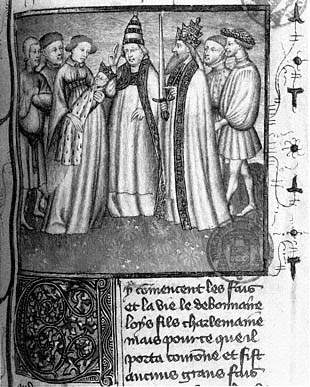
Figure 119
Coronation of Louis the Pious as king of Aquitaine.
Grandes Chroniques de France . Bibliothèque
Mazarine, Ms. 2028, fol. 131. Photograph by the author.
of the last Capetian king (Fig. 120). Never before had queens been included in these scenes. The second in particular shows the queen, an expectant mother, as an important protagonist in discussions about the future government of France. Probably because of the short lives of French dauphins (three had died by 1397), the image recalls an important theme in contemporary politics and literature—Queen Isabeau of Bavaria's role in the government of France and the hope that she would interfere to regulate the chaos caused by the rivalry of the dukes.
The major source of Isabeau's power was her role as one of the regents charged with the tutelle , or education, of the dauphin in case the king should die or be absent from the realm.[28] Charles V had been the first king since Saint Louis to give such a prominent role to the queen. His laws were adopted by Charles VI and his council in 1393—right after Charles's first attack of insanity—and remained in effect until 1407.[29] Under their provisions, Louis of Orléans became regent if the king died or was "absent," and Isabeau of Bavaria and the dukes of Burgundy and Berry were charged with the education of the prince. As royalist writers like Christine de Pizan recognized, Isabeau's role as guardian of the dauphin and peacemaker in a regency government became especially important once the dukes of Burgundy and Orléans became openly hostile in 1405.[30]
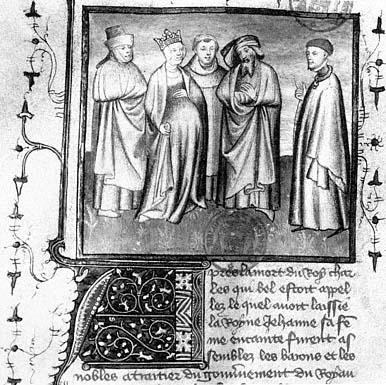
Figure 120
Discussion of the royal succession. Grandes Chroniques de France .
Bibliothèque Mazarine, Ms. 2028, fol. 354v. Photograph by the author.
The close relationship between royalist sentiment and pictorial imagery in the Grandes Chroniques in Paris continues in later chronicles by artists from the Cité des Dames workshop. The Grandes Chroniques in Brussels (B.R. 3) dates from the second decade of the fifteenth century when Charles VI's heir, Louis of Guyenne, was in his early teens. Perhaps as a result of the dauphin's maturity, distinctive miniatures in this book focus exclusively on the importance of the education of dauphins.
Three pictures in this book show the interaction of a king and his son. One shows King John the Good, Charles VI's grandfather, investing his young son, Charles, with the Dauphiné (Fig. 121). Two others offer examples of good and bad kingship that were especially appropriate to a dauphin named Louis. The miniature beginning Louis the Stammerer's life (Fig. 122) shows Louis compromising himself to gain power; he gives the barons anything they want in order to win their favor. In the process, Louis grasps his son's wrist to compel him to participate. A complementary image from another section of the chronicle shows the prince's willing compliance when his father is a positive influence. In this picture from the beginning of the life of Saint Louis (Fig. 123), the young Louis sits next to his father, Louis VIII, and helps supervise the burning of heretics.
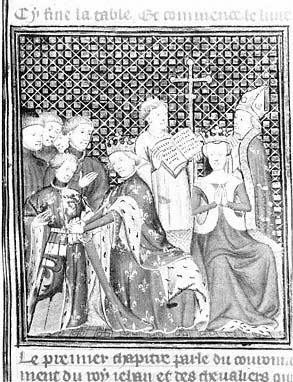
Figure 121
John the Good invests Charles with the Dauphiné.
Grandes Chroniques de France . Bibliothèque Royale,
Ms. 3, fol. 373.
Copyright Bibliothèque Royale Albert Ier, Brussels.
Neither miniature faithfully reflects the chronicle's text.[31] Louis the Stammerer had two sons—Louis and Carloman—neither of whom was mentioned in the chapter that this picture illustrates. Further, Saint Louis did not take part in his father's persecution of heretics; his father was in the south of France and Louis was in Paris. By departing from the text in representing kings with heirs named Louis, the artist created compositional and thematic analogies. They were apt choices for exempla at the time when Charles VI's son, Louis of Guyenne, was dauphin.
Like the emphasis on queenship in the Grandes Chroniques now in Paris, the focus on the dauphin in B.R. 3 paralleled contemporary historical events and reflected concerns expressed in contemporary literature. The ordinance of 1407 empowering Louis of Guyenne to rule during his father's "absences" made the dauphin the most important person in the realm besides the king. His education was addressed by Christine de Pizan in several works and by Jean Gerson in a treatise sent to the tutor of the dauphin, Jean d'Arsonval, and dated between 1408 and 1414.[32] These writings discussed the religious, moral, and intellectual formation of the future king and frequently cited examples of past kings, most notably Louis of Guyenne's famous ancestor, Saint Louis, as models of government.
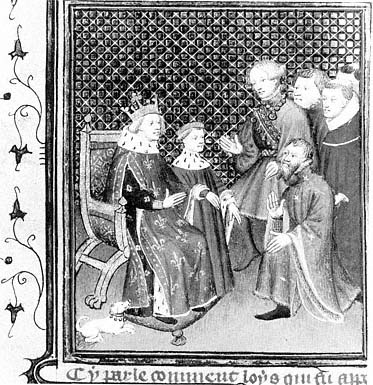
Figure 122
Louis the Stammerer and his son Louis accede to barons.
Grandes Chroniques de France . Bibliothèque Royale, Ms. 3,
fol. 147v. Copyright Bibliothèque Royale Albert Ier, Brussels.
Manuscripts decorated by the Master of the Cité des Dames provide insights into a special kind of courtly reaction to the French civil war. Like the illustrations in royal manuscripts before them, these images of history form a private complement to more overt political writings, featuring images of the contemporary powers in France—the dukes and the queen—and representing themes like the role of the dukes in governing France, the Burgundian-Orléanist conflict, the importance of the queen as mediator and peacemaker, and the education of the dauphin. As in the political literature of the time, these images offer an important perspective on the political climate of fifteenth-century France.
The Master of the Cité des Dames used various methods of illustration to gloss the chronicle and express his political message. The simpler way is to elaborate an individual picture that, when read with its own text, comments on contemporary events. This sort of elaboration ranges from the inclusion of characters described in the text but rarely visualized (as in Jeanne of Evreux's presence at the discussion of the royal succession in Mazarine 2028), to the addition of historical characters who contradict their text (Saint Louis happily burning heretics in B.R. 3), to the insertion of anachronistic emblems and devices into stock scenes (as in the Burgundian hammer and the Orléanist Order of the Porcupine in the frontispiece
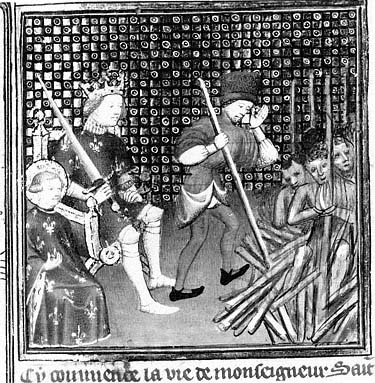
Figure 123
Louis VIII and his son Louis supervise the burning of heretics.
Grandes Chroniques de France . Bibliothèque Royale, Ms. 3,
fol. 248. Copyright Bibliothèque Royale Albert Ier, Brussels.
of Phillipps 1917). In these glosses, immediately perceptible to a careful reader of one chapter or the whole manuscript, the overarching message of the program of decoration conveys the same message as each individual part.
The Master of the Cité des Dames' s more complicated method of glossing encompasses the whole program of decoration. In this system, most commonly seen in kings' books, individual pictures carry only a portion of the message. Images work in sequences, building a message through repeated compositions (as in the series of coronations in M. 536) or through visual cross-referencing (as in the pair of exempla for the education of the dauphin in B.R. 3). The message of the whole is much more than a sum of its parts—and often is very subtle, perhaps explaining why this kind of cycle occurs most frequently in manuscripts like that in New York where the text has been edited to promote a partisan view.
These manuscripts provide important evidence for a changing view of history in the fifteenth century. In the late fourteenth and the early fifteenth century the princes of the blood emerged simultaneously as major participants in government and as important patrons of the arts,[33] and during the reign of Charles VI the blood relations of the king began to assume a special status—to share, in a sense, some of the holiness of the French king, as they shared some of the responsibilities
of government. At this time, therefore, the decorative programs in the Grandes Chroniques worked to extend to the king's blood relations the prologue's directive that the king should seek models in its pages. The conviction, held by the princes of the blood and the court, that the blood relations of the king also had a mandate to govern inspired the creation of such advice books as the Grandes Chroniques decorated by the Master of the Cité des Dames .